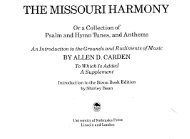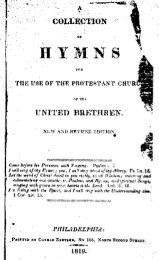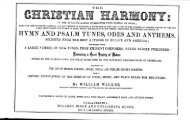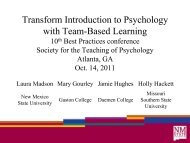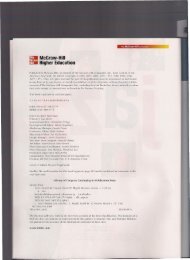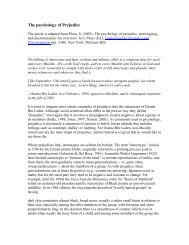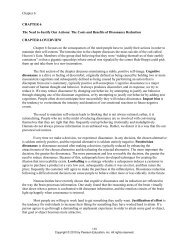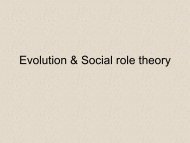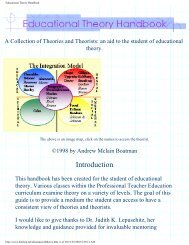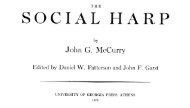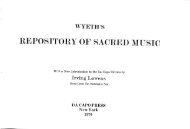Pozzebon et al.,2010
Pozzebon et al.,2010
Pozzebon et al.,2010
Create successful ePaper yourself
Turn your PDF publications into a flip-book with our unique Google optimized e-Paper software.
170 POZZEBON ET AL.<br />
sc<strong>al</strong>es only, and we computed sc<strong>al</strong>e scores from the items of<br />
the h<strong>al</strong>f-length form. All items were administered using a response<br />
sc<strong>al</strong>e with options ranging from 1 (strongly disagree)to5<br />
(strongly agree). Intern<strong>al</strong> consistency reliabilities (<strong>al</strong>pha) of the<br />
six HEXACO sc<strong>al</strong>es ranged from .79 to .84 in the community<br />
sample and from .81 to .84 in the college sample.<br />
Cognitive ability. In the community sample, we measured<br />
reasoning ability was measured by Factor B, a 15-item Reasoning<br />
sc<strong>al</strong>e, from the Sixteen Person<strong>al</strong>ity Factor Questionnaire<br />
(16PF; Conn & Rieke, 1994). Although the 16PF is a person<strong>al</strong>ity<br />
inventory, the items of its Reasoning sc<strong>al</strong>e are cognitive ability<br />
items, scored as correct or incorrect. The intern<strong>al</strong>-consistency<br />
reliability of the Reasoning sc<strong>al</strong>e was .75 in this sample.<br />
In the college sample, we administered two measures of<br />
ability. Verb<strong>al</strong> ability was measured with the 46 items of the<br />
Vocabulary sc<strong>al</strong>e from the Multidimension<strong>al</strong> Aptitude Battery<br />
(MAB; Jackson, 1984). Mathematic<strong>al</strong> ability was measured with<br />
a test consisting of 20 items taken from the Gauss Mathematics<br />
Contest (Center for Education in Mathematics and Computing,<br />
2007); the mathematics items assessed problem solving in arithm<strong>et</strong>ic<br />
and in basic <strong>al</strong>gebra and geom<strong>et</strong>ry. Intern<strong>al</strong>-consistency<br />
reliabilities of the verb<strong>al</strong> and mathematic<strong>al</strong> ability measures<br />
were .78 and .65, respectively.<br />
RESULTS<br />
Intern<strong>al</strong> Consistency Reliabilities<br />
Intern<strong>al</strong> consistency reliabilities and descriptive statistics for<br />
the ORVIS sc<strong>al</strong>es are reported in Table 1 for both the community<br />
and college samples. The reliabilities were gener<strong>al</strong>ly high in both<br />
samples, ranging from .79 and .75 for Erudition to .90 and .91<br />
for Organization, respectively.<br />
As shown in Table 1, the means for <strong>al</strong>l sc<strong>al</strong>es in both samples<br />
were reasonably close to the theor<strong>et</strong>ic<strong>al</strong> midpoints (i.e., 3.00<br />
for the 1–5 sc<strong>al</strong>es), and the standard deviations were reasonably<br />
wide, covering at least one fifth of the theor<strong>et</strong>ic<strong>al</strong> range.<br />
The mean scores for women and men indicated some sex differences<br />
in the sc<strong>al</strong>es. In both samples, the largest sex difference<br />
was in Adventure, with men’s scores more than a standard deviation<br />
higher than women’s scores. Men’s An<strong>al</strong>ysis scores were<br />
<strong>al</strong>so substanti<strong>al</strong>ly higher than were women’s (d >.5), whereas<br />
women scored higher on Altruism than did men (d >.5).<br />
Factor Structure of the ORVIS Items<br />
We <strong>al</strong>so conducted item-level factor an<strong>al</strong>yses of the 92 ORVIS<br />
items in each of the two samples. In both samples, we extracted<br />
eight princip<strong>al</strong> components and rotated them to an orthogon<strong>al</strong><br />
Procrustes solution based on a targ<strong>et</strong> matrix in which each item<br />
was assigned a targ<strong>et</strong> loading of 1 for its designated sc<strong>al</strong>e and<br />
0 for <strong>al</strong>l other sc<strong>al</strong>es (see the Appendix for the loading of each<br />
item on its targ<strong>et</strong>ed factor). In both samples, factor scores on<br />
the resulting factors correlated strongly with the corresponding<br />
sc<strong>al</strong>e scores: Correlations ranged from .69 (Erudition) to .94<br />
(Altruism) in the college sample and from .77 (Erudition) to .94<br />
(Organization and Altruism) in the community sample. Thus,<br />
the factor an<strong>al</strong>ysis results gener<strong>al</strong>ly supported the division of<br />
the ORVIS items into the eight specified sc<strong>al</strong>es. 2<br />
2 A confirmatory factor an<strong>al</strong>ysis of the ORVIS items is unsuitable for the<br />
following reasons. First, the ORVIS sc<strong>al</strong>es will not be strictly unidimension<strong>al</strong>,<br />
TABLE 1.—Means, standard deviations, and sex differences in the Oregon Vocation<strong>al</strong><br />
Interest Sc<strong>al</strong>es.<br />
Tot<strong>al</strong> Women Men<br />
Sc<strong>al</strong>e M SD M SD M SD d(Women–Men)<br />
Community sample<br />
Leadership (.87) 2.78 .76 2.66 .75 2.94 .75 −.37<br />
Organization (.90) 2.52 .79 2.48 .80 2.58 .77 −.12 ∗<br />
Altruism (.86) 3.15 .70 3.32 .65 2.93 .70 .60<br />
Creativity (.88) 3.22 .80 3.39 .81 2.99 .73 .53<br />
An<strong>al</strong>ysis (.88) 2.60 .87 2.38 .82 2.90 .84 −.62<br />
Production (.81) 3.17 .72 3.05 .71 3.34 .71 −.40<br />
Adventure (.82) 2.50 .77 2.20 .66 2.89 .73 −1.03<br />
Erudition (.79) 3.58 .69 3.40 .70 3.12 .65 .41<br />
College sample<br />
Leadership (.85) 2.90 .74 2.82 .74 3.10 .70 −.36<br />
Organization (.91) 2.38 .81 2.29 .77 2.58 .87 −.45<br />
Altruism (.84) 3.24 .70 3.40 .64 2.87 .69 .73<br />
Creativity (.89) 2.96 .86 3.01 .86 2.84 .86 .18 ∗<br />
An<strong>al</strong>ysis (.84) 2.08 .73 1.94 .64 2.42 .81 −.86<br />
Production (.82) 2.33 .73 2.22 .68 2.60 .76 −.49<br />
Adventure (.83) 2.78 .82 2.52 .69 3.40 .78 −1.11<br />
Erudition (.75) 2.84 .68 2.91 .68 2.69 .66 .29<br />
Note. Community N = 379 women, 286 men; college N = 245 women, 101 men.<br />
Intern<strong>al</strong>-consistency reliabilities are in parentheses.<br />
∗ ns; for <strong>al</strong>l other d v<strong>al</strong>ues, p



